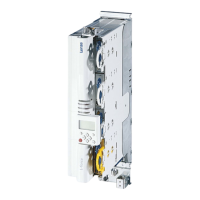E94AYCEN communication manual (Ethernet)
Commissioning
DHCP implementation in the Servo Drive 9400
34 L EDS94AYCEN EN 9.0 - 09/2012
6.3 DHCP implementation in the Servo Drive 9400
DHCP is the acronym for "Dynamic Host Configuration Protocol". This protocol is defined in
RFC 2131 and is an advancement on BOOTP (RFC 951). DHCP enables computers to query
information about the network configuration (e.g. IP address) from a server via a TCP/IP
network. The DHCP server assigns the IP address to the client dynamically, from a defined
address range. This means that the client always receives a new, but unique IP address.
DHCP is implemented in the firmware (program organisation unit RTCS). The following
chapter describes how the Servo Drive 9400 receives an IP address via DHCP.
DHCP code
For standard devices from version V03.xx.xx.xx, the DHCP codes C13005
and C14005 are
available. These codes can be used to define whether DHCP is to be used or not:
Value 0 (FALSE): Do not use DHCP (Lenze setting)
Value 1 (TRUE): Use DHCP
DHCP flag settings
UseIPfromDhcp = TRUE (Use DHCP):
The IP settings are assigned by the DHCP server.
UseIPfromDhcp = FALSE (Do not use DHCP):
The IP settings are assigned manually.
6.3.1 Basic terms
DHCP client
TCP/IP stack of a host. Network node that makes DHCP requests and is configured.
DHCP server
Network node that waits for DHCP requests and responds to them.
Lease time
Service life of the assigned IP address. After this period expires, the IP address will be
invalid. If it still needs to be used after this period, the lease time must be extended.

